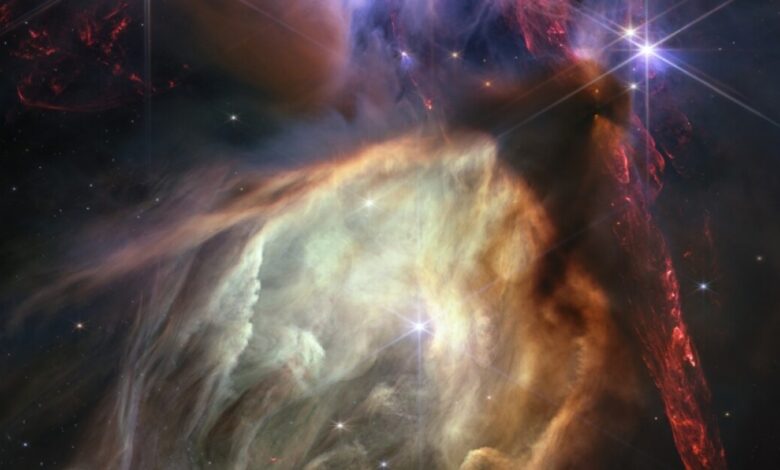
It's been one year since the James Webb Space Telescope beamed its first images of deep space back to Earth, and NASA marked the anniversary by releasing an "unprecedented" new imageinto the depths of the universe; 390 light-years away, to be exact.
The brilliant images reveal the birth of a sun-like star in the Rho Ophiuchi cloud complex, which NASA says is the closest star-forming region to Earth.
The $10 billion telescope captured a group of 50 glittering stars, marking the first time researchers have been able to clearly see the complex without other stars in the foreground.
NASA said the stars in this region are younger than the Sun, but have a similar amount of mass. The towering jets of red light are "huge bipolar jets of molecular hydrogen" shooting into opposite ends of space, which NASA compared to a "newborn first stretching her arms out into the world."
"Right now the gas and the dust and that big cloud is condensing and falling in on itself to form new stars," Mike Menzel, a NASA mission system engineer, told Scripps News. "We believe that the processes going on in that cloud complex are the same processes that gave birth to our sun about four and a half billion years ago."
It's just one of many images helping us gain a better understanding of deep space.
SEE MORE: Solar storm to make Northern Lights visible in multiple US states
Over the past year, Webb's discoveries include "rare" images of a dying star, distant and active supermassive black holes, and even photographs of some of the earliest galaxies in the universe that NASA believes existed near the dawn of time, about 13 billion years ago, when the universe was just 5% of its current age.
More recently, Webb captured an infrared image of Saturn and its rings to look for previously undiscovered moons circling the planet.
But one of the most amazing aspects of Webb is that no matter where the telescope points, it can see hundreds of galaxies, all with varying numbers of stars.
"If you held a grain of sand on the tip of your finger at arm's length, that is the part of the universe that you're seeing. Just one little speck of the universe," said NASA Administrator Bill Nelson after unveiling the telescope's first images last year.
It can also find exoplanets, which are planets that orbit distant stars outside the solar system. Menzel says the photos are proof that galaxies are evolving more quickly than scientists thought and could be key to solving life's biggest mysteries.
"Looking at exoplanets, looking at the chemistry and the process of that chemistry is a stepping stone to answering the question, how common is life?"
In the coming years, Menzel says scientists are pointing the Webb at an intriguing solar system that could support life.
"There is a system called the Trappist system that has multiple planets around it, some of them in what we might term the habitable zone ... a region around their star where the temperatures might be right for liquid water and to have conditions similar to the Earth," said Menzel.
In a news release, Nelson said: "Webb is an investment in American innovation but also a scientific feat made possible with NASA's international partners that share a can-do spirit to push the boundaries of what is known to be possible."
It's an attitude that Menzel echoes wholeheartedly.
"I think whatever's out there in the deep universe, James Webb's going to see it."
Trending stories at Scrippsnews.com









